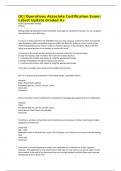Exam (elaborations)
OCI Operations Associate Certification Exam|Latest Update Graded A+
- Course
- Institution
OCI Operations Associate Certification Exam|Latest Update Graded A+ Audit Log Retention Period? 90 days Setting Audit Log Retention Period. By default, Audit logs are retained for 90 days. You can configure log retention for up to 365 days. You have recently joined the Site Reliability te...
[Show more]



